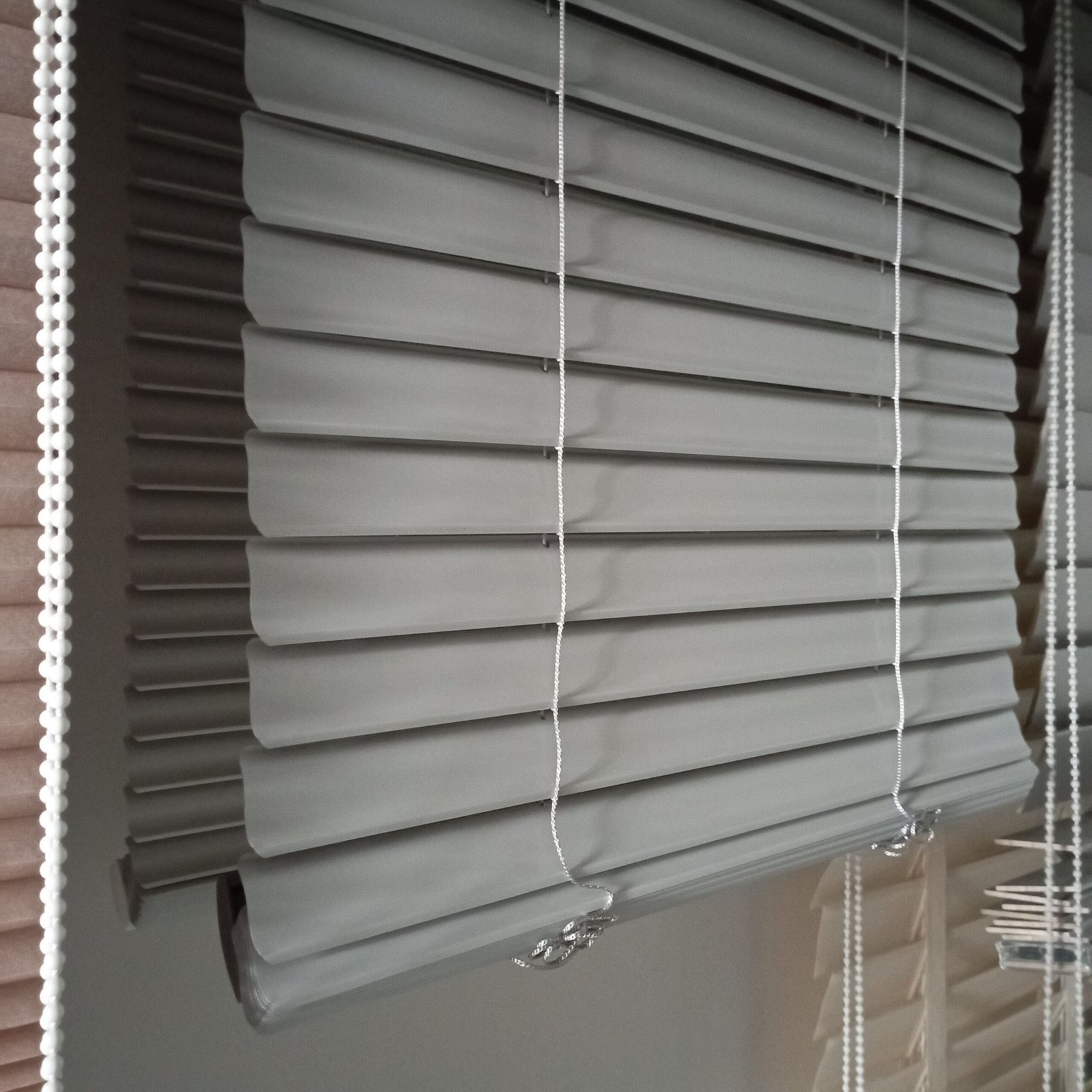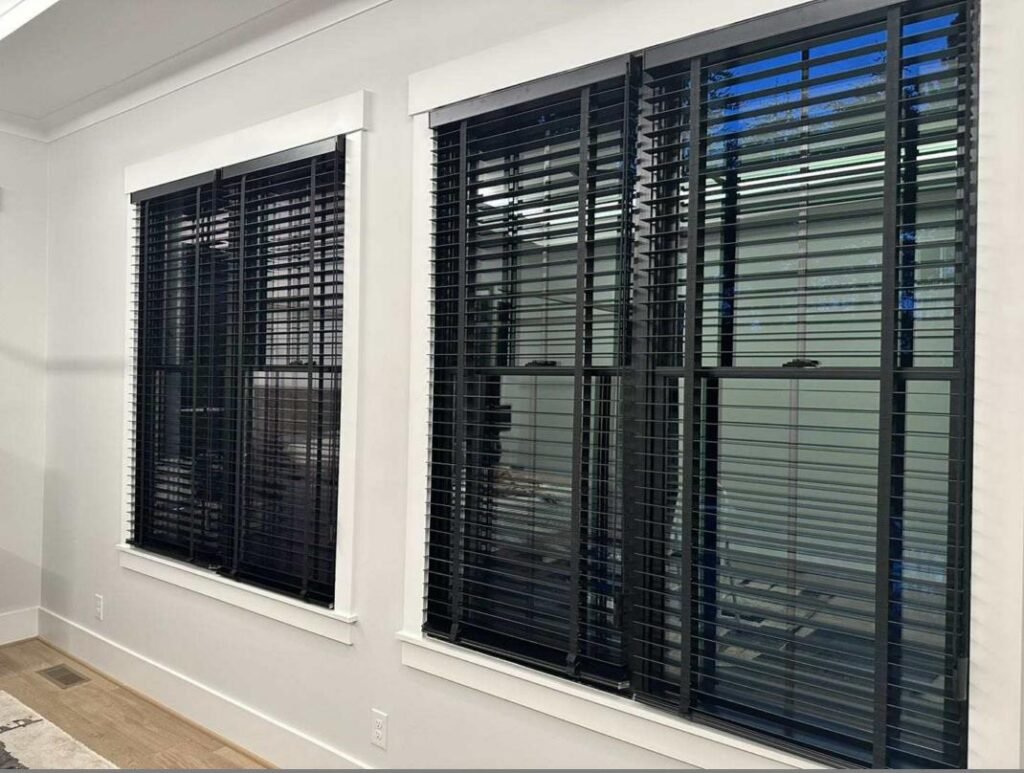Shopping for window blinds can quickly become overwhelming with all the material options available. Price often becomes the deciding factor, but understanding the true cost differences between aluminum and wood blinds requires looking beyond just the initial purchase price.
Aluminum blinds typically cost $20-50 per square foot while wood blinds range from $50-120 per square foot on average. However, aluminum blinds generally last 5-7 years while quality wood blinds can last 20+ years with proper care, making the lifetime cost comparison more complex.

Let me break down the key factors that influence the pricing of both aluminum and wood blinds, based on my years of experience working with manufacturers and project contractors. The initial cost is just one piece of the puzzle – we need to consider durability, maintenance requirements, and long-term value.
Are Aluminum Blinds Really Better Than Faux Wood?
Many of my clients initially lean toward aluminum blinds due to their lower upfront cost. However, the decision between aluminum and faux wood isn’t as straightforward as it may seem, especially when considering long-term value.
Aluminum blinds offer better moisture resistance and lightweight operation at $20-50/sq ft, while faux wood provides superior insulation and durability at $40-80/sq ft. The better choice depends on specific application needs like humidity levels, light control requirements, and budget constraints.

Having worked on numerous commercial and residential projects, I’ve observed that the "better" choice heavily depends on several key factors. Let’s analyze this through multiple lenses:
Performance Characteristics
| Feature | Aluminum Blinds | Faux Wood Blinds |
|---|---|---|
| Durability | 5-7 years average lifespan | 10-15 years average lifespan |
| Light Control | Excellent (smaller slat options) | Good (limited by minimum slat size) |
| Insulation (R-value) | 0.9-1.2 | 2.5-3.0 |
| Moisture Resistance | Excellent | Good |
| Weight | 0.5-1 lb/sq ft | 2-3 lb/sq ft |
Cost Analysis (Based on 2023 Market Data)
- Initial Purchase Cost:
- Aluminum: $20-50/sq ft
- Faux Wood: $40-80/sq ft
- Installation Cost:
- Aluminum: $5-10/sq ft
- Faux Wood: $8-15/sq ft
- Annual Maintenance:
- Aluminum: $2-4/sq ft
- Faux Wood: $1-2/sq ft
Application-Specific Considerations
-
High Moisture Areas:
- Aluminum performs better in bathrooms and kitchens
- Faux wood can warp in extremely humid conditions
-
Large Windows:
- Aluminum’s lighter weight makes operation easier
- Faux wood may require motorization for larger sizes
-
Energy Efficiency:
- Faux wood provides significantly better insulation
- Can impact HVAC costs by 5-15% annually
Based on project data and client feedback, I’ve found that faux wood blinds[^1] often provide better long-term value despite higher upfront costs, especially in residential settings with moderate humidity levels.
What Are The Key Disadvantages Of Aluminium Blinds?
In my consulting work, I often encounter clients who are attracted to aluminum blinds’ affordability but aren’t aware of their potential limitations. Understanding these drawbacks is crucial for making an informed decision.
The main disadvantages of aluminum blinds include lower insulation value (R-value of 0.9-1.2), susceptibility to bending/denting, higher noise levels during operation, and limited aesthetic options compared to wood or faux wood alternatives.

Through extensive project experience and client feedback, I’ve identified several critical disadvantages that buyers should consider:
Technical Limitations
-
Structural Integrity:
- Slat Thickness: 6-8mm standard (vs 10-12mm for wood)
- Bend Resistance: 2-3x lower than wood/faux wood
- Impact Resistance: Significantly lower than alternative materials
-
Thermal Performance:
- R-value: 0.9-1.2 (compared to 2.5-3.0 for wood)
- Heat Transfer Rate: 15-20% higher than wood
- Energy Cost Impact: 10-15% less efficient
Maintenance and Durability Issues
| Aspect | Impact | Annual Cost Implication |
|---|---|---|
| Denting | Common with regular use | $5-10/sq ft repair |
| Color Fading | UV exposure effects | Replacement needed every 5-7 years |
| Noise Level | 45-55 dB during operation | Potential comfort issue |
| Cleaning Requirements | Monthly deep cleaning needed | $2-4/sq ft maintenance |
Project-Specific Challenges
Based on real project experiences:
-
Commercial Applications:
- Higher replacement frequency
- Limited warranty coverage
- Increased maintenance budgets
-
Residential Settings:
- Lower perceived value
- Limited color matching options
- Higher noise complaints
Are Wooden Blinds More Expensive Than Other Options?
This question comes up frequently in my consultations with project managers and interior designers. The answer requires a nuanced understanding of both immediate and long-term costs.
Yes, wooden blinds are generally more expensive initially, ranging from $50-120 per square foot compared to aluminum ($20-50) or faux wood ($40-80). However, their 20+ year lifespan and superior insulation properties often result in lower lifetime costs.
[^2] and natural light](https://velablinds.com/wp-content/uploads/2025/06/4-5.jpg)
Let’s dive into a comprehensive cost analysis based on real project data:
Initial Cost Breakdown
| Component | Wood Blinds | Aluminum | Faux Wood |
|---|---|---|---|
| Materials | $45-100/sq ft | $15-40/sq ft | $35-70/sq ft |
| Installation | $10-20/sq ft | $5-10/sq ft | $8-15/sq ft |
| Hardware | $5-15/sq ft | $3-8/sq ft | $4-10/sq ft |
Long-term Value Considerations
-
Durability Metrics:
- Average Lifespan: 20+ years
- Warranty Coverage: 10-15 years
- Repair Frequency: Every 5-7 years
-
Energy Efficiency Impact:
- Annual HVAC Savings: 15-20%
- R-value Contribution: 3.0-3.5
- Solar Heat Gain Reduction: 45-60%
-
Property Value Enhancement:
- ROI on Installation: 65-75%
- Resale Value Impact: 3-5% increase
- Buyer Preference Rating: 8.5/10
What Type Of Blinds Commands The Highest Price Point?
Based on my experience in the window treatment industry, this question requires examining various premium blind categories and their pricing factors.
Custom motorized wooden blinds[^3] with smart home integration typically command the highest prices, ranging from $150-300 per square foot. These systems incorporate premium hardwoods, advanced automation technology, and professional installation.

Let’s analyze the premium blind market segmentation:
Premium Blind Categories by Price Range
-
Top-Tier Materials:
- Exotic Hardwoods: $120-200/sq ft
- Designer Fabrics: $100-180/sq ft
- Premium Composites: $80-150/sq ft
-
Advanced Features:
- Motorization: +$50-100/sq ft
- Smart Home Integration: +$30-80/sq ft
- Custom Finishes: +$25-50/sq ft
Market Analysis of Premium Features
| Feature | Price Premium | Value Add |
|---|---|---|
| Motorization | 40-60% | Convenience, Luxury |
| Custom Sizing | 25-35% | Perfect Fit |
| Designer Materials | 50-70% | Aesthetics, Durability |
| Smart Integration | 30-50% | Modern Functionality |
Extended FAQ Section
How much should I budget for window blinds in a 2000 sq ft home?
For a 2000 sq ft home with approximately 15-20 windows, you should budget:
- Economy Option: $3,000-5,000 (Aluminum/Vinyl)
- Mid-Range Option: $6,000-10,000 (Faux Wood)
- Premium Option: $12,000-20,000 (Real Wood/Motorized)
These estimates include:
- Material Costs (60% of budget)
- Installation (25% of budget)
- Hardware and Accessories (15% of budget)
Consider additional factors like:
- Window sizes and quantities
- Material quality tiers
- Automation requirements
- Local labor rates
- Special features (blackout, light filtering)
What is the average lifespan of different types of window blinds?
Based on industry data and maintenance patterns:
| Blind Type | Average Lifespan | Maintenance Level |
|---|---|---|
| Aluminum | 5-7 years | Medium |
| Faux Wood | 10-15 years | Low |
| Real Wood | 20+ years | High |
| Vinyl | 7-10 years | Low |
Factors affecting lifespan:
- Usage frequency
- Environmental conditions
- Maintenance regularity
- Installation quality
- Material grade
How much can I save annually on energy bills with proper window blinds?
According to Department of Energy studies and project data:
-
Average Energy Savings:
- Summer cooling: 15-25%
- Winter heating: 10-20%
- Annual HVAC: $100-200 per window
-
Factors Affecting Savings:
- Climate zone
- Window orientation
- Blind material R-value
- Usage patterns
- HVAC system efficiency
What material offers the best value for money in window blinds?
Faux wood blinds typically offer the best value proposition:
Cost-Benefit Analysis:
- Initial Investment: $40-80/sq ft
- Lifespan: 10-15 years
- Maintenance Costs: $1-2/sq ft annually
- Energy Efficiency: R-value 2.5-3.0
Comparative Value Metrics:
- Cost per year of use
- Energy savings return
- Maintenance requirements
- Durability ratings
- Style versatility
How often should different types of blinds be professionally cleaned?
Professional cleaning frequency recommendations:
| Blind Type | Cleaning Frequency | Professional Cost |
|---|---|---|
| Aluminum | Every 6 months | $10-15/blind |
| Wood | Annually | $15-20/blind |
| Faux Wood | Every 9 months | $12-18/blind |
| Fabric | Every 4 months | $20-25/blind |
Maintenance Factors:
- Environmental conditions
- Usage patterns
- Location in home
- Ventilation quality
- Dust levels
What are the hidden costs of window blind ownership?
Long-term ownership costs include:
-
Maintenance:
- Regular cleaning: $2-5/blind monthly
- Professional service: $100-200 annually
- Parts replacement: $20-50/incident
-
Energy Impact:
- Efficiency losses over time
- Climate control adjustments
- UV damage protection
-
Operational Costs:
- Battery replacement (motorized)
- Mechanism lubrication
- Control system updates
Conclusion
While aluminum blinds offer lower upfront costs, wood blinds often provide better long-term value through superior durability and energy efficiency. The choice depends on specific project requirements, budget constraints, and long-term objectives.
---
[^1]: Explore the advantages of faux wood blinds, including durability and energy efficiency, to make an informed choice for your home.
[^2]: Understanding how window blinds affect energy efficiency can help you save on HVAC costs and improve comfort in your home.
[^3]: Discover the convenience and luxury of motorized wooden blinds, perfect for modern smart homes and enhancing your living space.Partner with VelaBlinds for Your Next Project
Smart window treatments shouldn’t be complicated. After working with 500+ distributors and contractors worldwide, I’ve streamlined the process to get you quality products, competitive pricing, and reliable support – every time.
Why project professionals choose VelaBlinds:
- ✅ Fast, Accurate Quotes – Detailed specs and pricing within 24 hours
- ✅ Transparent Pricing – No hidden fees, volume discounts clearly outlined
- ✅ Quality Assurance – Direct partnerships with certified OEM manufacturers
- ✅ Project Support – Dedicated account manager from quote to delivery
Start your next project:
📧 Quick Quote: Send your requirements to info@velablinds.com
📱 Direct Contact: WhatsApp +86 137 2012 8317
🌐 Browse Solutions: https://velablinds.com/
📁 Product Resources: Access spec sheets, catalogs & project files
Jimmy Chen, Founder
"I built VelaBlinds to solve the real challenges I faced as a project buyer – long lead times, unclear specs, and unreliable suppliers. Let’s discuss how we can power your projects with smarter blinds."
Serving distributors and contractors across North America, Europe, and Australia since 2018.





